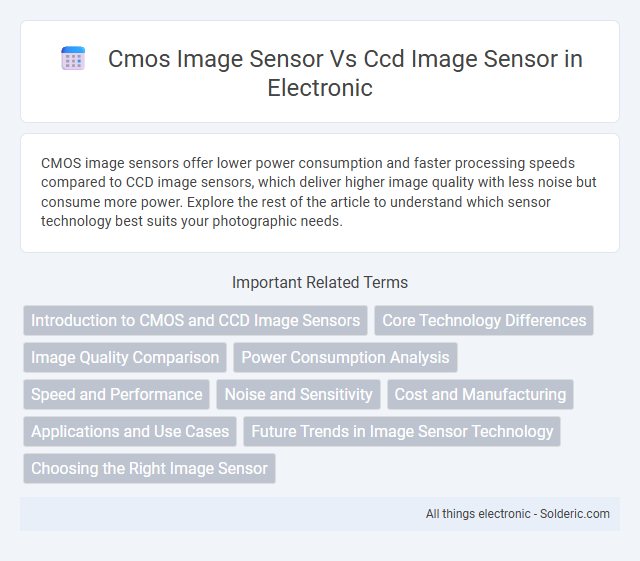CMOS image sensors offer lower power consumption and faster processing speeds compared to CCD image sensors, which deliver higher image quality with less noise but consume more power. Explore the rest of the article to understand which sensor technology best suits your photographic needs.
Comparison Table
| Feature | CMOS Image Sensor | CCD Image Sensor |
|---|---|---|
| Technology | Complementary Metal-Oxide-Semiconductor | Charge-Coupled Device |
| Power Consumption | Low power consumption | High power consumption |
| Cost | Lower cost, easy to integrate | Higher cost, complex manufacturing |
| Image Quality | Good, with noise reduction improvements | Excellent, low noise, high-quality images |
| Speed | Faster readout speeds | Slower readout speeds |
| Sensitivity | Generally lower sensitivity | Higher sensitivity to light |
| Dynamic Range | Wide dynamic range with modern designs | Typically narrower dynamic range |
| Application | Smartphones, digital cameras, automotive | Scientific imaging, high-end cameras |
Introduction to CMOS and CCD Image Sensors
CMOS (Complementary Metal-Oxide-Semiconductor) and CCD (Charge-Coupled Device) image sensors are fundamental technologies used in digital imaging to convert light into electronic signals. CMOS sensors integrate amplifiers and analog-to-digital converters directly on the chip, enabling lower power consumption and faster readout speeds. CCD sensors, known for high image quality and low noise, transfer charge across the sensor to a single output node, making them preferred in applications requiring superior image fidelity.
Core Technology Differences
CMOS image sensors use complementary metal-oxide-semiconductor technology integrating photodiodes and amplification circuitry on the same chip, enabling faster readout speeds and lower power consumption. CCD sensors rely on charge transfer through a limited number of output nodes, achieving higher image quality and better low-light performance but with increased power usage. Understanding these core technology differences helps you choose the optimal sensor type for specific imaging requirements.
Image Quality Comparison
CMOS image sensors offer faster processing speeds with lower power consumption while maintaining high image quality, suitable for low-light conditions due to improved noise reduction techniques. CCD image sensors traditionally deliver superior image quality with higher sensitivity and better color fidelity, making them preferred for professional photography and scientific applications. Advances in CMOS technology have narrowed the quality gap, often providing comparable or better dynamic range and resolution in modern devices.
Power Consumption Analysis
CMOS image sensors demonstrate significantly lower power consumption compared to CCD image sensors due to their on-chip amplification and parallel signal processing architecture. The integration of active pixel sensors (APS) in CMOS technology reduces energy usage by enabling selective pixel readout and dynamic power scaling. CCD sensors require higher operational voltages and continuous charge transfer, leading to increased power dissipation, which makes CMOS sensors more suitable for battery-powered and portable imaging devices.
Speed and Performance
CMOS image sensors offer faster readout speeds compared to CCD sensors due to their on-chip signal processing capabilities, making them ideal for high-speed photography and video applications. CCD sensors typically deliver higher image quality in low-light conditions but at the expense of slower frame rates and increased power consumption. Your choice between CMOS and CCD should consider the balance between required speed and performance for your specific imaging needs.
Noise and Sensitivity
CMOS image sensors exhibit lower noise levels due to integrated on-chip noise reduction technologies and smaller pixel sizes, enhancing image clarity. CCD image sensors generally offer higher sensitivity with better light absorption, making them preferable in low-light conditions. However, advances in CMOS fabrication have significantly improved sensitivity, narrowing the performance gap between the two technologies.
Cost and Manufacturing
CMOS image sensors offer lower manufacturing costs due to simpler fabrication processes and the ability to integrate additional circuitry on the same chip, enhancing cost-efficiency for mass production. CCD image sensors involve more complex manufacturing with higher power consumption and specialized processes, driving up overall expenses. Your choice will impact budget considerations, as CMOS sensors provide a cost-effective solution for consumer electronics, while CCDs often cater to specialized applications requiring higher image fidelity despite higher costs.
Applications and Use Cases
CMOS image sensors excel in applications requiring low power consumption and high-speed image capture, such as smartphones, automotive cameras, and surveillance systems. CCD image sensors are preferred in professional photography, medical imaging, and scientific research due to their superior image quality and low noise performance. Your choice depends on whether rapid processing and energy efficiency or high image fidelity is the priority for your project.
Future Trends in Image Sensor Technology
Future trends in image sensor technology emphasize the growing dominance of CMOS image sensors due to their lower power consumption, faster readout speeds, and superior integration capabilities compared to CCD sensors. Advances in CMOS technology focus on enhancing pixel size reduction, improving quantum efficiency, and integrating AI-driven processing on-chip to boost image quality and real-time analysis. Meanwhile, CCD technology is being gradually phased out in most consumer applications but may still find niche uses in specialized scientific imaging where ultra-low noise and high dynamic range are essential.
Choosing the Right Image Sensor
Choosing the right image sensor depends on your specific requirements for image quality, power consumption, and cost. CMOS image sensors offer faster processing speeds, lower power consumption, and better integration with digital circuits, making them ideal for smartphones and real-time applications. CCD image sensors provide superior image quality with less noise, making them suitable for professional photography and scientific imaging where precision is crucial.
cmos image sensor vs ccd image sensor Infographic

 solderic.com
solderic.com